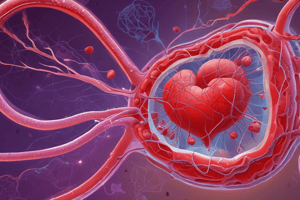Podcast
Questions and Answers
How is nitric oxide formed from arginine?
How is nitric oxide formed from arginine?
enzyme nitric oxide synthase (NOS) utilizing NADPH and molecular oxygen
What is the significance of constitutive and inducible forms of nitric oxide synthase?
What is the significance of constitutive and inducible forms of nitric oxide synthase?
- Regulate blood pressure
- Involved in cellular communication
- Affected by ischemia reperfusion injury
- Play a critical role in endothelial function (correct)
NO˙ diffuses freely across cell membranes and acts in a ________ fashion.
NO˙ diffuses freely across cell membranes and acts in a ________ fashion.
paracrine or even autocrine
Reperfusion injury is caused by the restoration of normal function after ischemia.
Reperfusion injury is caused by the restoration of normal function after ischemia.
What is the enzyme targeted by NO that generates the second messenger cyclic GMP?
What is the enzyme targeted by NO that generates the second messenger cyclic GMP?
Study Notes
Biochemical Basis of Cardiovascular Diseases
- Nitric oxide (NO˙) is a highly reactive free radical formed from arginine by the enzyme nitric oxide synthase (NOS) which utilizes NADPH and molecular oxygen.
Nitric Oxide Synthase (NOS)
- There are three isoforms of NOS: neuronal NOS (nNOS), inducible NOS (iNOS), and endothelial NOS (eNOS).
- Constitutive forms of NOS (nNOS and eNOS) are involved in physiological processes, while inducible form (iNOS) is involved in immune responses.
Nitric Oxide (NO˙) Receptors
- NO˙ diffuses freely across cell membranes and acts in a paracrine or autocrine fashion, affecting only cells near its point of synthesis.
- NO˙ binds to protein receptors, triggering an allosteric change in the protein, which in turn triggers the formation of a "second messenger" (cGMP) within the cell.
Mechanism of Action of NO
- NO activates guanylate cyclase by diffusing into adjacent smooth muscle.
- Increased cyclic GMP (cGMP) activates protein kinase G (PKG) in smooth muscles, dephosphorylates myosin light chains, and leads to relaxation of smooth muscles, causing vasodilation.
Physiological Actions of NO
- Vasodilation: eNOS releases NO, maintaining blood pressure, and dilates cerebral, coronary, renal, and muscle arteries.
- Stimulates release of hormones: CRH, GHRH, and LHRH in the CNS.
- Role in macrophages: iNOS in macrophages produces NO and peroxynitrite, which are lethal to microorganisms, providing host immune defense.
Reperfusion Injury
- Reperfusion injury is the tissue damage caused when blood supply returns to the tissue after a period of ischemia or lack of oxygen.
- The absence of oxygen and nutrients from blood during the ischemic period creates a condition in which the restoration of circulation results in inflammation and oxidative damage.
- Xanthine oxidase activity increases during ischemia and on reperfusion, causing conversion of hypoxanthine to xanthine and superoxide anion.
- Allopurinol, a xanthine oxidase inhibitor, reduces the severity of reperfusion injury.
Studying That Suits You
Use AI to generate personalized quizzes and flashcards to suit your learning preferences.
Description
Understand the biochemical basis of cardiovascular diseases, including the role of nitric oxide, ischemia and reperfusion injury, and the L-arginine: NO pathway. Learn about the isoforms of nitric oxide synthase and their significance.




